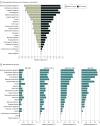Epidemiology and Costs of Postsepsis Morbidity, Nursing Care Dependency, and Mortality in Germany, 2013 to 2017
- PMID: 34767025
- PMCID: PMC8590172
- DOI: 10.1001/jamanetworkopen.2021.34290
Epidemiology and Costs of Postsepsis Morbidity, Nursing Care Dependency, and Mortality in Germany, 2013 to 2017
Abstract
Importance: Sepsis survivorship is associated with postsepsis morbidity, but epidemiological data from population-based cohorts are lacking.
Objective: To quantify the frequency and co-occurrence of new diagnoses consistent with postsepsis morbidity and mortality as well as new nursing care dependency and total health care costs after sepsis.
Design, setting, and participants: This retrospective cohort study based on nationwide health claims data included a population-based cohort of 23.0 million beneficiaries of a large German health insurance provider. Patients aged 15 years and older with incident hospital-treated sepsis in 2013 to 2014 were included. Data were analyzed from January 2009 to December 2017.
Exposures: Sepsis, identified by International Statistical Classification of Diseases and Related Health Problems, Tenth Revision (ICD-10) hospital discharge codes.
Main outcomes and measures: New medical, psychological, and cognitive diagnoses; long-term mortality; dependency on nursing care; and overall health care costs in survivors at 1 to 12, 13 to 24, and 25 to 36 months after hospital discharge.
Results: Among 23.0 million eligible individuals, we identified 159 684 patients hospitalized with sepsis in 2013 to 2014. The mean (SD) age was 73.8 (12.8) years, and 75 809 (47.5%; 95% CI, 47.2%-47.7%) were female patients. In-hospital mortality was 27.0% (43 177 patients; 95% CI, 26.8%-27.3%). Among 116 507 hospital survivors, 86 578 (74.3%; 95% CI, 74.1%-74.6%) had a new diagnosis in the first year post sepsis; 28 405 (24.4%; 95% CI, 24.1%-24.6%) had diagnoses co-occurring in medical, psychological, or cognitive domains; and 23 572 of 74 878 survivors (31.5%; 95% CI, 31.1%-31.8%) without prior nursing care dependency were newly dependent on nursing care. In total, 35 765 survivors (30.7%; 95% CI, 30.4%-31.0%) died within the first year. In the second and third year, 53 089 (65.8%; 95% CI, 65.4%-66.1%) and 40 959 (59.4%; 95% CI, 59.0%-59.8%) had new diagnoses, respectively. Health care costs for sepsis hospital survivors for 3 years post sepsis totaled a mean of €29 088/patient ($32 868/patient) (SD, €44 195 [$49 938]). New postsepsis morbidity (>1 new diagnosis) was more common in survivors of severe sepsis (75.6% [95% CI, 75.1%-76.0%]) than nonsevere sepsis (73.7% [95% CI, 73.4%-74.0%]; P < .001) and more common in survivors treated in the intensive care unit (78.3% [95% CI, 77.8%-78.7%]) than in those not treated in the intensive care unit (72.8% [95% CI, 72.5%-73.1%]; P < .001). Postsepsis morbidity was 68.5% (95% CI, 67.5%-69.5%) among survivors without prior morbidity and 56.1% (95% CI, 54.2%-57.9%) in survivors younger than 40 years.
Conclusions and relevance: In this study, new medical, psychological, and cognitive diagnoses consistent with postsepsis morbidity were common after sepsis, including among patients with less severe sepsis, no prior diagnoses, and younger age. This calls for more efforts to elucidate the underlying mechanisms, define optimal screening for common new diagnoses, and test interventions to prevent and treat postsepsis morbidity.
Conflict of interest statement
Figures



References
-
- Torio CM, Moore BJ. National inpatient hospital costs: the most expensive conditions by payer, 2013. Statistical Brief #204. Healthcare Cost and Utilization Project (HCUP). May 2016. Accessed October 12, 2021. https://www.hcup-us.ahrq.gov/reports/statbriefs/sb204-Most-Expensive-Hos...
MeSH terms
LinkOut - more resources
Full Text Sources
Medical

